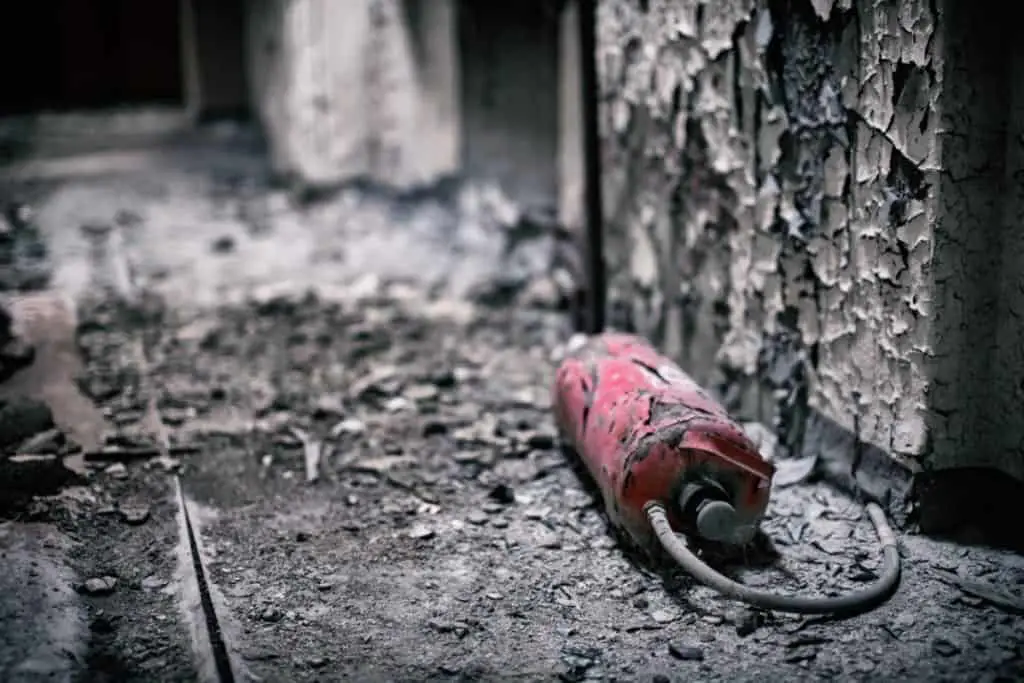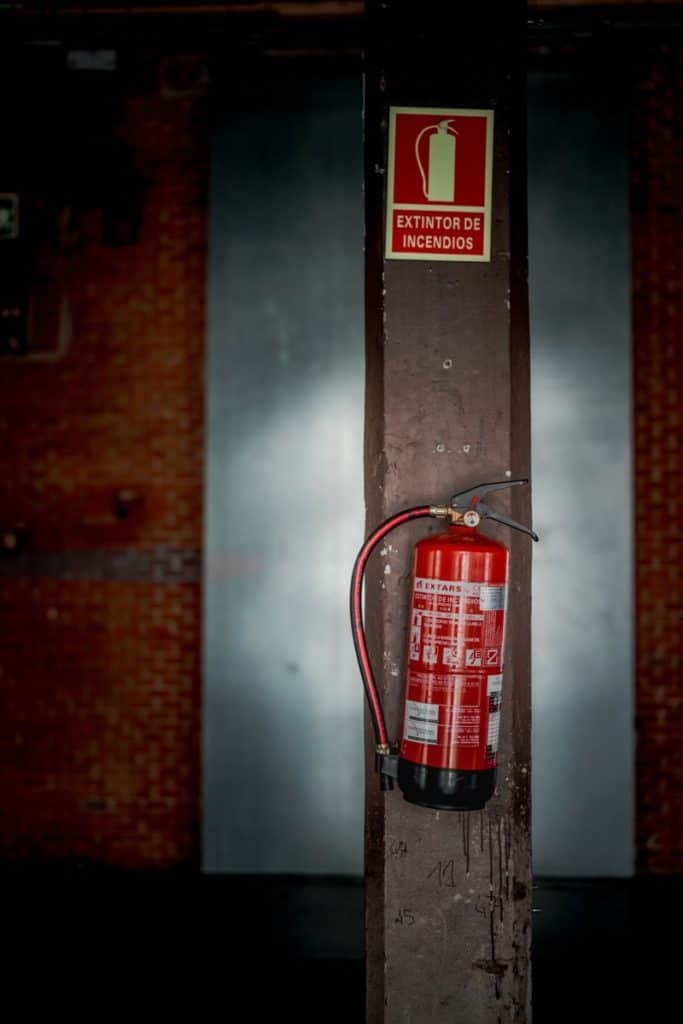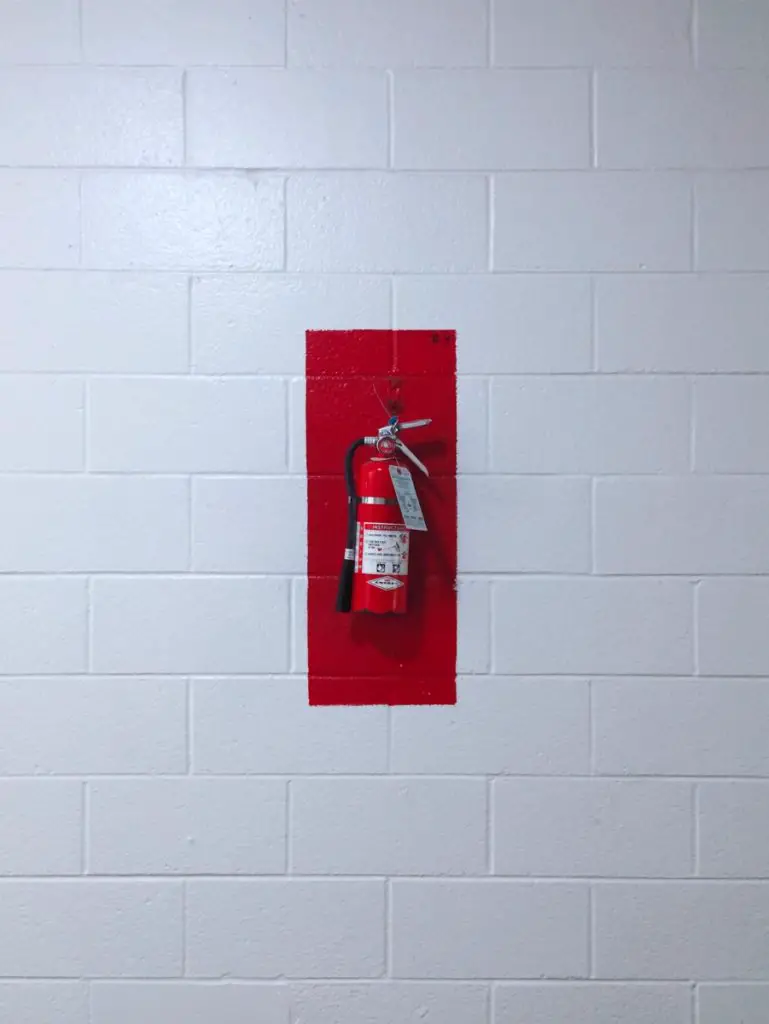Fire extinguishers are a vital part of any fire safety plan no matter what kind of building you are in, but it’s amazing how often these life and property saving devices are not stored properly. Without proper storage and preparation, the closest fire extinguisher might not be accessible enough to stop a fire.
So, how do you store a fire extinguisher safely? Fire extinguishers should be stored upright in a visible location with signage and without environmental obstruction, preferably in above freezing temperatures. Fire extinguishers should be kept up-to-date and within the maximum travel distance recommended for storage (75 feet).
Fire extinguishers are only as useful as they are accessible. Keep reading to find out more about how you should store your fire extinguishers to ensure that they are ready whenever you might need them.
Fire Extinguisher Temperature and Storage Safety
One significant advantage of fire extinguishers is that they are operational at a wide variety of temperatures, making them suitable for both indoor and outdoor use in all climate conditions.
Most fire extinguishers can be stored from approximately -40 degrees Fahrenheit to 120 degrees Fahrenheit without suffering damage or operational difficulties. When temperatures exceed or fall below this range, the extinguisher may not operate as intended.
- High temperatures: Fire extinguishers stored at temperatures higher than 120 degrees Fahrenheit may still function, but the discharge time for the fire suppressant chemicals can be shortened to far less than the 9-10 seconds recommended by the Fire Safety Research Institute. Because they are tolerant of high temperatures even in trunk storage without combusting, it is recommended to keep a fire extinguisher on hand in your vehicle as well.

- Low temperatures: Fire extinguishers that are kept at temperatures below -40 degrees Fahrenheit may suffer mechanical defects because of material compression related to low temperatures, such as cracked valves and hoses. This can result in the fire extinguisher being rendered nonfunctional.
Fire extinguishers can be stored at many different temperatures without a threat of combustion, so it is a good idea to keep them stored in multiple areas as a precaution.
Fire Extinguishers and Storage Time
Another major advantage of fire extinguishers other than their flexibility in storage temperature is the amount of time they remain operational. The average lifespan of a fire extinguisher (if well-maintained) is five to fifteen years, which means that even though a suitable fire extinguisher may be a bit pricey, it is an investment that will easily pay for itself.
It’s also essential to have fire extinguishers regularly serviced and inspected by a fire safety inspector. These inspectors can determine whether your fire extinguisher is still up to operational standards and can replace it for you if not.
Fire Extinguishers and Storage Placement
When it comes to fire extinguishers, storage placement is crucial. There is no point in having fire extinguishers stored where people don’t have easy access to them in case of an emergency, as precious time will end up wasted while someone tries to get the extinguisher.
The National Fire Protection Association (NFPA) recommends that each floor of a home or building has fire extinguisher access.
It is also important that fire extinguishers are kept stored at an appropriate height. Fire extinguishers should be stored low enough in the room that anyone, regardless of height (even a child), could easily access it in case of a fire.
Fire Extinguishers and Storage Position
Fire extinguishers should be stored in the upright position, as this keeps the fire suppressant chemicals at the bottom of the tank where they belong. Fire extinguishers stored in a horizontal position may not function as effectively as those which are stored vertically.
The larger a fire extinguisher is, the lower it should be mounted on the wall for effective operation. Fire extinguishers should be located between 3 and 5.5 feet from the floor, with larger extinguishers located at the lower end of that range.
While modern fire extinguishers can be safely stored horizontally, older fire extinguisher models stored horizontally may suffer from particulates within the fire extinguisher tank building up in the discharge tube and nozzle. This can potentially impede the effectiveness of the fire extinguisher during operation. Some local fire codes also require that fire extinguishers be stored vertically to reflect older model designs.
When fighting fire with multiple extinguishers, place expended extinguishers on their side. This signals to other firefighters which extinguishers have been used up and which are still operational.
Fire Extinguishers and Maximum Travel Distance
In fire safety, the maximum travel distance is the maximum recommended distance that an operator should be forced to travel to find an operational fire extinguisher. To meet this maximum travel distance, this means that most buildings must have at least one fire extinguisher stored per floor of the building for people to have close access.
The best way to ensure that maximum travel distance is met by fire extinguisher storage is to identify high-risk areas for fire in the building and store the fire extinguisher within 75 feet of that area.
Fire Extinguishers and Danger Areas
In the process of deciding where to store your fire extinguishers, the first thing you should do is determine the highest areas of risk in the building where a fire might break out. This might include areas that contain the following:
- Open flames
- Flammable materials
- A heavy electrical load
While it’s essential to keep fire extinguishers stored near these danger areas, it’s also important to realize that due to building wiring and the sheer amount of electronics that are utilized in the rooms of most buildings, the chance of an electrical fire is present in most rooms of both residential and business buildings. That means when it comes to sourcing fire extinguishers – the more, the merrier.
Fire Extinguishers and Visibility
Another critical aspect of safety with regards to fire extinguisher storage is making sure that the fire extinguisher is easily visible—not just to people familiar with the home or building, but also to any visitors who may be called upon to help suppress a fire.

To store a fire extinguisher safely, the extinguisher should be mounted on the wall in plain sight, with associated signage to draw attention to its location. Signage for a fire extinguisher should contain the following:
- English instructions
- Black, red, and white coloring
- Instructional wording: TO USE FIRE EXTINGUISHER: PULL PIN, AIM AT BASE OF FIRE, SQUEEZE HANDLE, SWEEP SIDE TO SIDE
This signage is used almost universally to indicate both the location and the correct usage of a fire extinguisher, which means if a fire extinguisher is stored near proper signage, there is a higher chance it will be used effectively and successfully to suppress a fire.
Arrows and lighting are also effective methods to direct people to the nearest fire extinguisher, especially in darkened areas. Fire extinguishers should be stored with their labels facing out so that they can be easily read in the heat of an emergency.
Fire Extinguishers and Environmental Protection
Fire extinguishers that are used in commercial or residential settings are usually in temperature-controlled environments and do not require a lot of extra coddling. However, fire extinguishers that are stationed in dirty environments or environments where the fire extinguisher might be tampered with by the public may be stored beneath a protective plastic cover rather than out in the open.
It is also important that the path to the nearest fire extinguisher is not obstructed by furniture, storage items, or any other obstacle which might increase the amount of time it takes to find and operate a portable fire extinguisher. The longer it takes a firefighter to reach the fire extinguisher, the longer a fire must grow out of control in the meantime.
At a certain point, fire extinguishers can no longer contain ablaze, so for their effectiveness, fire extinguishers must be stored where they are protected from the environment so that they don’t end up damaged, and also so that the environment doesn’t obstruct their use when the time comes.
Fire Extinguishers and Quantity in Storage
When planning a fire safety layout for your home or office building, it is always better to have too many fire extinguishers than not enough. Make sure that there are plenty of fire extinguishers in storage beyond what is mounted on the wall, especially if you have any high-risk areas for fire, such as a kitchen.
It’s also essential to make sure that fire extinguishers are mounted and distributed throughout the building rather than all stored in one location since their effectiveness depends on their relative proximity to the fire at its beginning when it can still be easily controlled.
Fire Extinguishers and Accessibility
The most important thing when installing fire extinguishers, whether it is in an office, a workshop, or a home, is that their effectiveness depends on how accessible they are to everyone in the building. That means you must go out of your way to do the following:
- Make sure that everyone knows exactly where the fire extinguishers are stored.
- Make sure that everyone knows how to get the fire extinguishers out of storage for operation and how to operate them properly in case of a real fire.
Teaching fire extinguisher locations and safe operation is an excellent addition to any general fire safety plan for the office and home. The more people who are aware of fire safety, the fewer people will be caught unawares during a fire.
Fire Extinguisher Storage in the Home
A fire is one of the deadliest tragedies that can strike a household, particularly if a fire breaks out in the evening when most of the household is asleep. The following are some of the high-risk areas of the home where fire extinguishers should be stored:
- Kitchen: Half of all home fires start in the kitchen. Along with having a fire extinguisher stored in the kitchen, residents should also know about other kitchen fire hazards, such as throwing water on an oil fire and leaving cooking food unattended. Combustible items such as paper or fabric should also be kept away from the stovetop.
- Bedroom: Bedrooms are full of highly flammable objects, from bedding to books and papers. This makes them a fire trap without some means of suppressing fire and escaping the room. Storing a fire extinguisher in the bedroom can allow a person who has been trapped by flames to clear an exit path.
- Fireplaces and chimneys: Many house fires start as the result of dirty chimneys and unattended (or poorly tended) fireplaces. A fire extinguisher should be stored near the fireplace in case anything near the fireplace becomes ignited, and a fire screen should be installed to help keep combustible items away from the hearth.
- Living room: Living room fires are usually the result of fireplaces or electrical wiring shortages. Like bedrooms, living rooms are also full of combustible items such as blankets, furniture, carpet, drapery, and pillows. If you do not want to store a fire extinguisher directly in the living room because of aesthetics, it should be stored nearby in an adjacent room.
- Laundry room: Laundry room fires are often the result of dryer lint not being cleaned out of hoses and filters in the dryer unit. A fire extinguisher should be stored near the laundry room, but care should also be taken to clean out dryer lint regularly.
- Outdoor fires: When grilling, building a bonfire, or setting off fireworks, you should always have fire extinguishers stationed nearby in case the fire tries to travel. In dry outdoor conditions, fire can quickly spread to the house itself or even adjacent homes.
- Car: A car fire can be extremely damaging to your vehicle and potentially lethal if the gas tank blows, so make sure you have a fire extinguisher handy in case someone drops a cigarette in your floorboard or some similar accident occurs. Car extinguishers can also be used on camping trips to monitor campfires.
NOTE: Keep in mind that you should not try to fight any kind of car fire in the engine compartment. Keep away from the vehicle. A car on fire may explode.
Knowing where a fire is most likely to break out in your home (or your car) is the best way to consider where and how many fire extinguishers you should store.
Fire Extinguisher Storage in the Workplace
Office buildings, warehouses, and other commercial buildings must have plenty of fire extinguishers available for operation in case of an emergency, but more than that, it’s vital for businesses to train their employees in the operation and inspection of in-house fire extinguishers.
This dramatically increases the chances of someone successfully using the extinguisher in an emergency; it is also the recommendation of the Occupational Safety and Health Administration (OSHA) that no employee use a portable fire extinguisher unless specially trained in the operation of the extinguisher as an extension of their duties in the workplace.

Not only that, but employers are also required to perform monthly visual inspections of their firefighting equipment, though this inspection process is not required to be documented for OSHA inspection. Fire extinguishers should be inspected by professional fire safety inspectors at least once a year to ensure proper working order.
It is also crucial that fire extinguishers never be stored under locked conditions, as this defeats the purpose of having them in the workplace.
Other Fire Safety Equipment to Store with Fire Extinguishers
Along with fire extinguishers, several other pieces of fire safety equipment should be stored in homes and businesses to increase the effectiveness of firefighting attempts:
- Smoke detectors: If a fire occurs in a room where nobody is present, a smoke detector can be the difference between suppressing the fire with a nearby fire extinguisher and losing the room (or possibly the building) to fire damage.
- Carbon monoxide detectors: The kinds of combustible indoor appliances that start house fires such as gas-powered heaters and malfunctioning chimneys also can cause a dangerous build-up of deadly carbon monoxide gas.
- Fire blankets: Along with available fire extinguishers, a fire blanket can be used to quickly douse the flames on a person who has been engulfed. Fire blankets are a useful safety item to have in industrial or camping scenarios where proximity to high temperatures and fire is more likely.
Fire extinguishers alone are not enough to safeguard your home or office from an accidental fire. Having a comprehensive fire safety plan can help prevent a tragedy.
Storing Fire Extinguishers Properly Is Important
Many people have fire extinguishers in their homes or offices without thinking twice about them in the course of their daily business, but knowing how to store and use a fire extinguisher properly can be the difference between handling a potentially deadly situation with calm and proficiency, or standing out on the sidewalk and watching your house burn down while you wait on the fire department.
